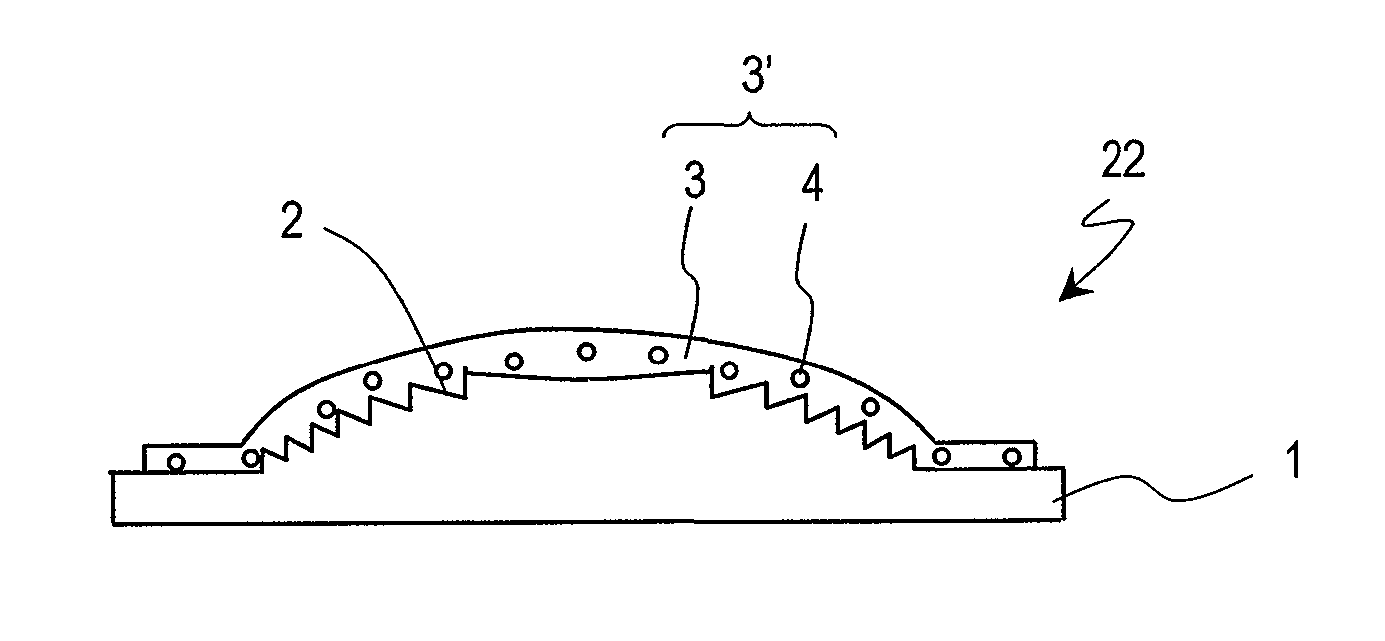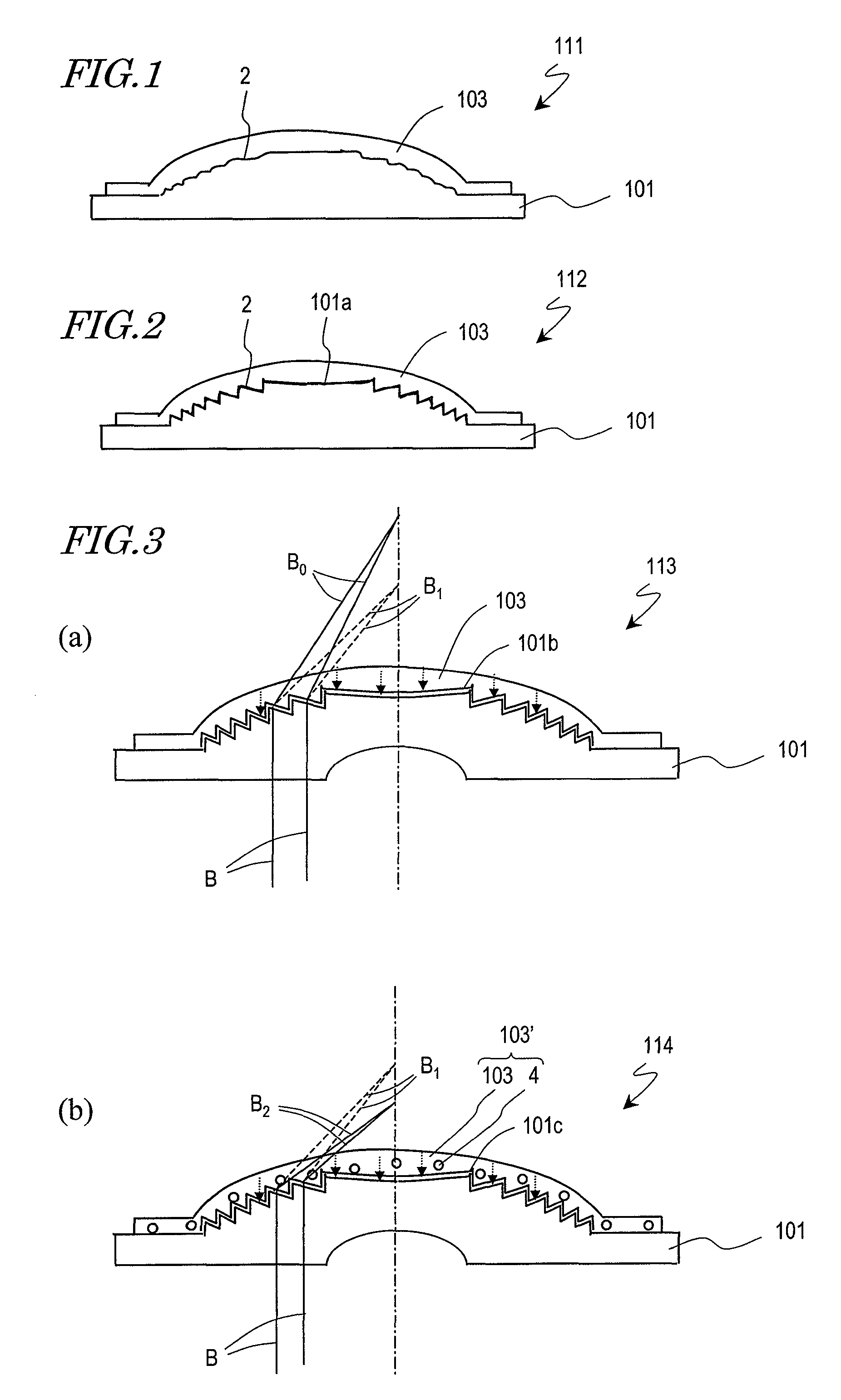Diffractive optical element and manufacturing method thereof
a technology manufacturing methods, applied in the field of diffractive optical elements, can solve the problems of uneven color and flare, low diffraction efficiency of light of any other wavelength, and difficulty in building an optical system having appropriate optical characteristics with diffractive optical elements alone, and achieve good optical characteristics
- Summary
- Abstract
- Description
- Claims
- Application Information
AI Technical Summary
Benefits of technology
Problems solved by technology
Method used
Image
Examples
first embodiment
(First Embodiment)
[0063]FIGS. 5(a) and (b) are a cross-sectional view and an upper plan view showing a first embodiment of the diffractive optical element according to the present invention. A diffractive optical element 21 shown in FIGS. 5(a) and (b) includes a body 1 and an optical adjustment layer 3.
[0064]The body 1 is composed of a first optical material containing a first resin, and has a diffraction grating 2 on its surface. In the present embodiment, the first optical material only contains the first resin. The cross-sectional shape, positioning, pitch, and depth of the diffraction grating 2 are to be determined based on the optical characteristics of the body 1 and the optical adjustment layer 3 and the optical characteristics which are required of the diffractive optical element 21. For example, in order to confer a lens action to the diffractive optical element 21, an annular diffraction grating having a sawtooth cross-sectional shape is provided in the form of concentric ...
second embodiment
(Second Embodiment)
[0091]FIG. 6 is a cross-sectional view showing a second embodiment of the diffractive optical element according to the present invention. As shown in FIG. 6, a diffractive optical element 22 includes a body 1 and an optical adjustment layer 3′.
[0092]Similarly to the first embodiment, the body 1 is composed of a first optical material containing a first resin, and has a diffraction grating 2 on its surface. The diffraction grating 2 has a similar structure to that of the first embodiment.
[0093]A second optical material composing the optical adjustment layer 3′ contains a second resin 3 and inorganic particles 4. The second resin 3 and the inorganic particles 4 together compose a composite material such that the inorganic particles 4 are dispersed in a matrix of the second resin 3. The difference in solubility parameter between the first resin and the second resin 3 is equal to or greater than 0.8 [cal / cm3]1 / 2.
[0094]By using the composite material in which the inorg...
third embodiment
(Third Embodiment)
[0117]Hereinafter, an embodiment of a production method of the diffractive optical element according to the present invention will be described. In the present embodiment, with reference to FIGS. 7(a) to (f) and FIGS. 8(a) to (d), a method of producing the diffractive optical element 21 of the first embodiment will be described.
[0118]First, as shown in FIG. 7(a), a body 1 having a diffraction grating 2 formed on its surface is provided. For example, the body 1 having the diffraction grating 2 formed thereon can be produced by: a method of performing molding by supplying a first optical material in a softened or melted state into a mold in which a diffraction grating shape has been formed, such as injection molding or press forming; a method of injecting a monomer, oligomer, or the like as a raw material of the first optical material into a mold in which a diffraction grating shape has been formed, and polymerizing the raw material via heating and / or energy beam irr...
PUM
| Property | Measurement | Unit |
|---|---|---|
| particle size | aaaaa | aaaaa |
| particle size | aaaaa | aaaaa |
| viscosity | aaaaa | aaaaa |
Abstract
Description
Claims
Application Information
 Login to View More
Login to View More - R&D
- Intellectual Property
- Life Sciences
- Materials
- Tech Scout
- Unparalleled Data Quality
- Higher Quality Content
- 60% Fewer Hallucinations
Browse by: Latest US Patents, China's latest patents, Technical Efficacy Thesaurus, Application Domain, Technology Topic, Popular Technical Reports.
© 2025 PatSnap. All rights reserved.Legal|Privacy policy|Modern Slavery Act Transparency Statement|Sitemap|About US| Contact US: help@patsnap.com



